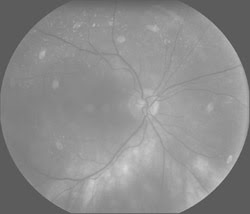Optical coherence tomography (OCT) enables ophthalmologists to view details of the structures of the human eye, noninvasively and with submicron resolution. In 2006, the FDA approved the use of spectral domain OCT, which offers higher definition, a faster scan time and better accuracy than the previously used time domain version, as well as 65 times higher resolution.
However, with a better system also comes a higher price. Dr. Jennifer Barton of the University of Arizona in Tucson said that the commercially available systems are priced beyond the reach of most users, with used Stratus ophthalmic OCT systems from Carl Zeiss Meditec Inc. of Pleasanton, Calif., available on resale sites such as eBay for around $30,000. Thorlabs Inc. of Newton, N.J., offers a laboratory system for about $35,000, but it is not FDA-approved and so cannot be used in clinics. Systems that have received FDA approval typically cost about $70,000.

Shown is an eye imaged with OCT. Courtesy of Dr. Andrew Lee.
According to Dr. Andrew Lee of the University of Iowa in Iowa City, the main cost is hardware, and coming up with that large a sum up front can be prohibitive for a small practice. He also mentioned, though, that some companies offer leasing options or purchase plans that would help buyers spread out the initial cost. The software changes often but the hardware does not, which makes maintaining the system less expensive than purchasing it.
Breaking it down
The systems typically pay for themselves in a year or two, thanks to their diagnostic accuracy and convenience, though OCT would have to be a regularly performed diagnostic to make the purchase worthwhile. A cost-benefit analysis performed in mid-2008 by the Veterans Affairs Healthcare System in Boston determined that the cost of its OCT machine was recovered after four months of use.
The analysis compared the annual cost of using only fluorescein angiogram (FA) for the diagnosis of macular disease with the annual cost of using both FA and OCT. The study found that in the year before the OCT system was purchased, 411 FAs were performed at a cost of $297,498 – an average of about $724 per test. The year after the OCT system was purchased, 692 diagnostic procedures were performed with a total cost of $325,695 – an average of about $471 per test, or an approximately 35 percent decrease in the cost per test. Of the 692 diagnostic procedures, there were 336 FAs at $243,210 and 356 OCTs at $82,485, which shows that, while the cost of performing an FA remained stable, performing an OCT exam cost only about $232 per test.
In addition to the dramatic cost difference, the study determined that OCT has none of the adverse events that, while rare, do occur with FA. The Healthcare System found that five adverse events occurred with FA over the two years being studied, at a total cost of approximately $3750.
According to Donny L. Chang at Boston University School of Medicine, the intention of the study was to show that it would be a better decision financially for small veterans affairs clinics to purchase and use an OCT machine, as they could then evaluate patients on-site and send them to another clinic for follow-up care if needed.
Expanding the market
While there is no consensus about whether the price of OCT systems is too high for them to be ubiquitous, there are developments happening in various segments of the industry that could reduce the price and squelch the argument entirely. According to Barton, one of the most expensive parts of the system is the light source. Research is being done to create a less expensive alternative that will still provide high performance, but turning technology into components will take time. The development of smart signal processing and plug-in sample probes also could make the system an affordable tool, she said.
When asked what the ideal price for an OCT system would be, Barton responded that it “should cost no more than a good microscope – around $5000.” This is a drastic decrease from the current price of the systems – 14 times less than the current FDA-approved models – but it would make the use of OCT a matter of fact, rather than a matter of cash.
Where is OCT going?
Size: Currently, an OCT system is room-size. As with much technology, though, developments are taking place to shrink the device, possibly to the point where it will be a portable, pocket-size instrument. This would allow doctors who travel from clinic to clinic to perform OCT exams on-site, minimizing patient travel.
Software: This is the most rapidly evolving component of the OCT system, and each software incarnation offers capabilities that previously were only a dream. New software is being created to enable OCT users to analyze greater amounts of data and to compare it to normative data.
Quality: As always, everyone wants more. More speed, better resolution and higher registration are being developed to enable the systems to take images quickly while tracking eye movements and avoiding the blink response.